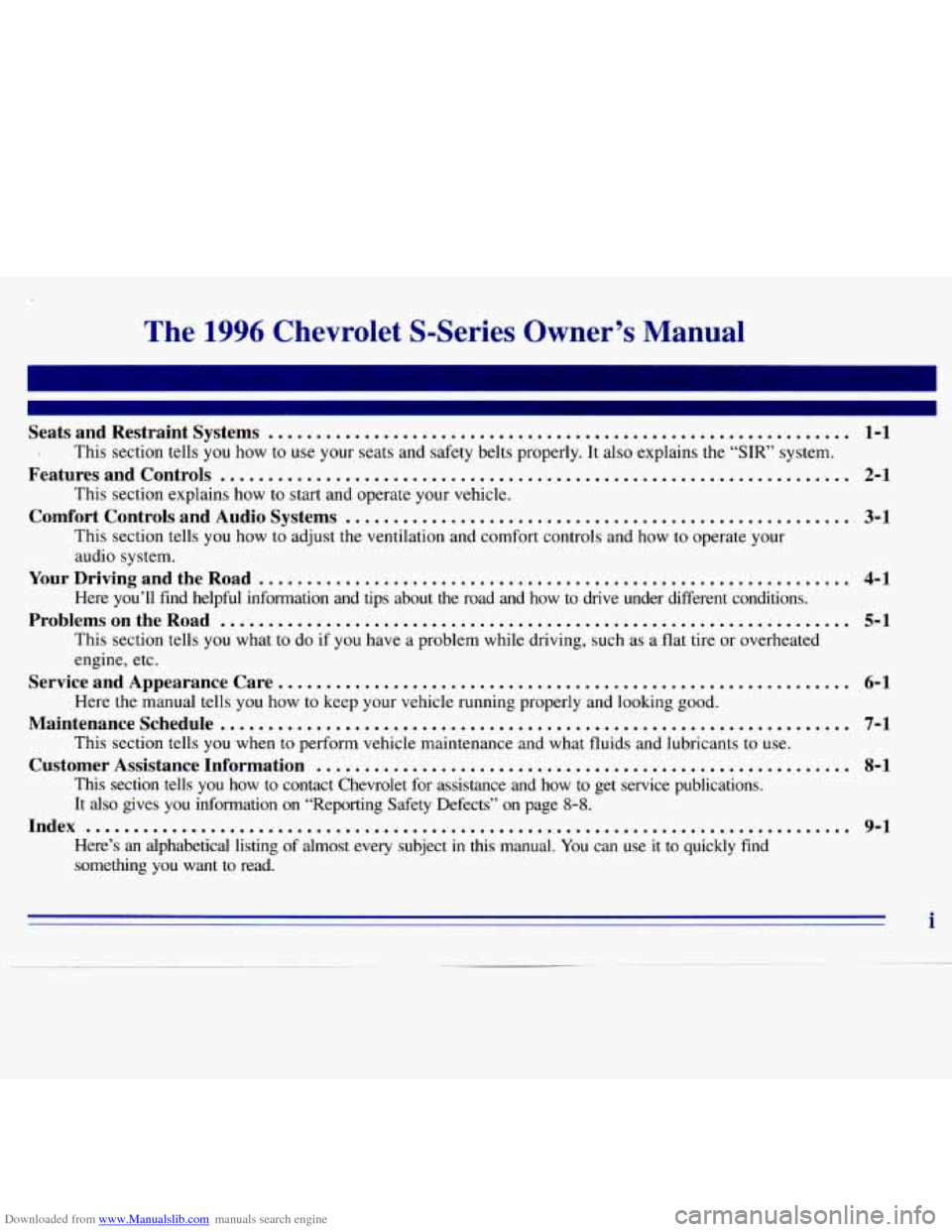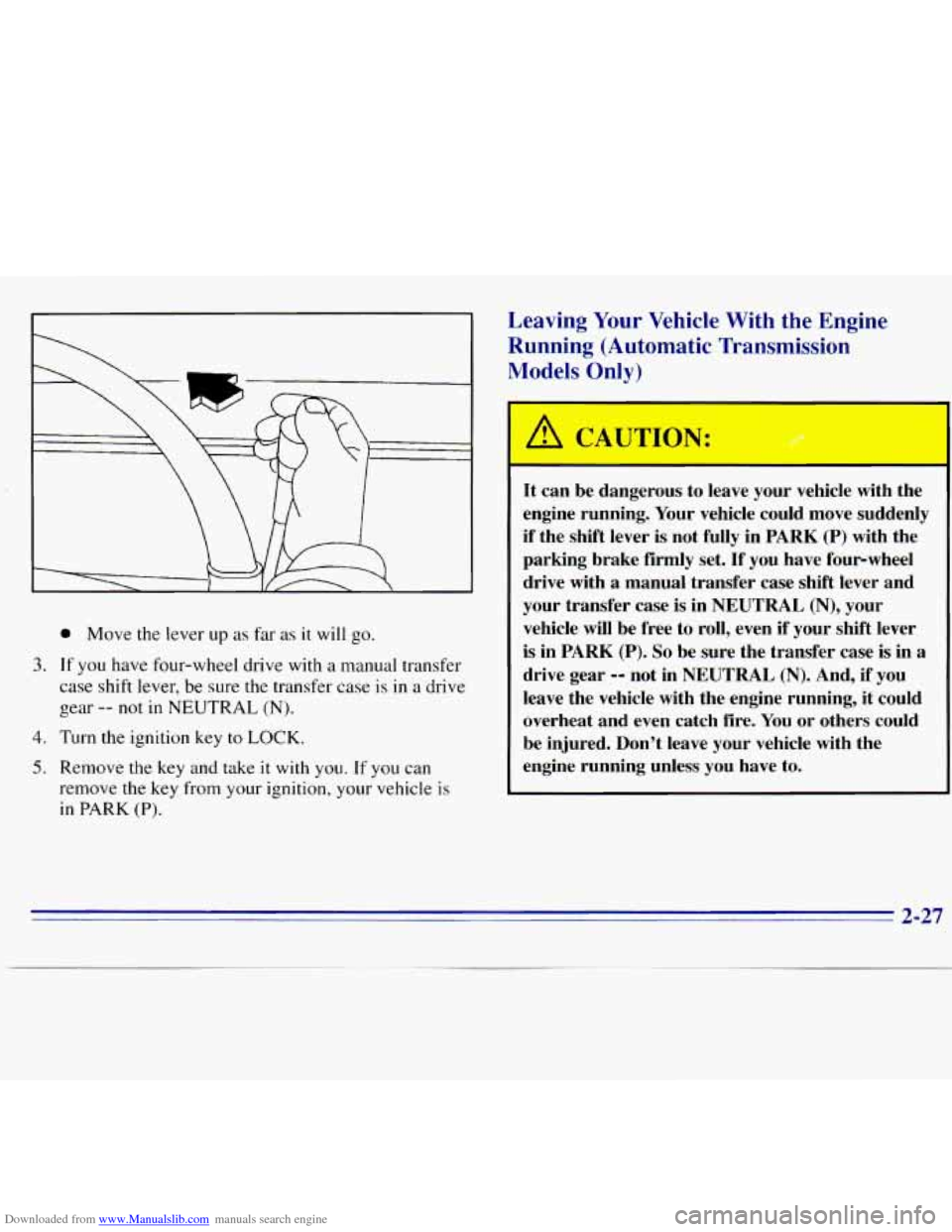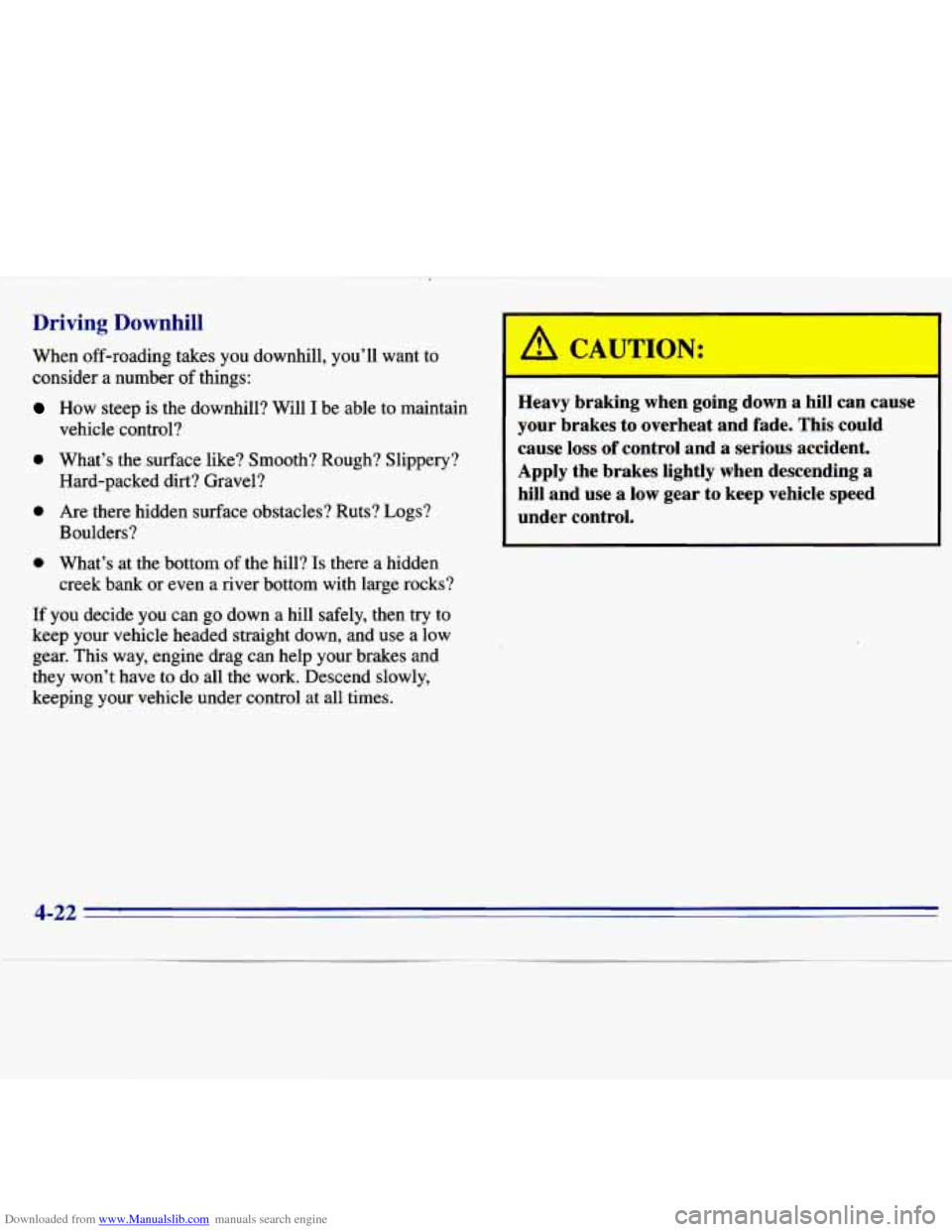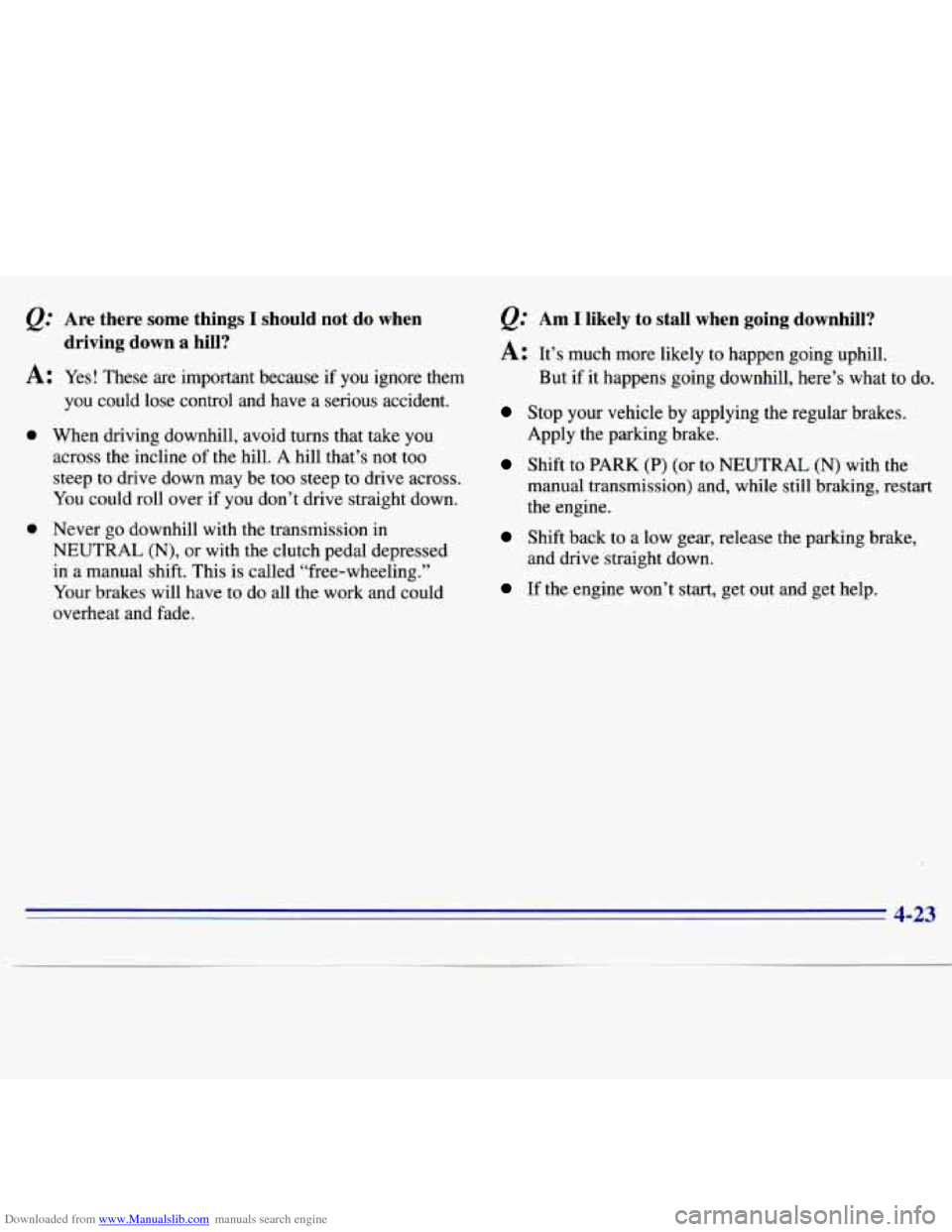Page 2 of 375

Downloaded from www.Manualslib.com manuals search engine The 1996 Chevrolet S-Series Owner’s Manual
Seats and Restraint Systems ............................................................. 1-1
. This section tells you how to use your seats and safety belts properly. It also explains the\
“SIR’ system.
FeaturesandControls .................................................................. 2-1
Comfort Controls and Audio Systems ..................................................... 3-1
This section explains how to start and operate your vehicle.
This section tells you how to adjust the ventilation and comfo\
rt controls and how
to operate your
audio system.
Here you’ll find helpful information and tips about the road\
and how to drive under different conditions.
This section tells
you what to do if you have a problem while driving, such as a flat tire or overheated
engine, etc.
Here the manual tells
you how to keep your vehicle running properly and looking good.
This section tells
you when to perform vehicle maintenance and what fluids and lubricants to u\
se.
This section tells
you how to contact Chevrolet for assistance and how to get service publica\
tions.
It
also gives you information on “Reporting Safety Defects” on page 8-8.
Here’s an alphabetical listing of almost every subject in this manual. You can use it to quickly find
something
you want to read.
YourDrivingandtheRoad .............................................................. 4-1
ProblemsontheRoad .................................................................. 5-1
Service and Appearance Care ............................................................ 6-1
Maintenanceschedule........ .......................................................... 7-1
Customer Assistance Information ........................................................ 8-1
Index ........................................................................\
........ 9-1
i
Page 64 of 375
Downloaded from www.Manualslib.com manuals search engine Engine Coolant Heater (Option)
“VORTEC” 4300 Engine 2.2L Engine
In very cold weather,
0°F (- 18°C) or colder, the engine
coolant heater can help. You’ll get easier starting and
better fuel economy during engine warm-up. Usually,
the coolant heater should be plugged
in a minimum of
four hours prior to starting your vehicle.
To use the coolant heater:
1. Turn off the engine.
2. Open the hood and unwrap the electrical cord.
3. Plug it into a normal, grounded 110-volt AC outlet.
1
Plugging the cord into an ungrounded outlet
could cause an electrical shock. Also, the wrong
kind
of extension cord could.overheat and cause
a fire.
You could be seriously injured. Plug the
cord into
a properly grounded three-prong
110-volt
AC outlet. If the cord won’t reach, use a
heavy-duty three-prong extension cord rated for
at least
15 amps.
2-13
Page 68 of 375
Downloaded from www.Manualslib.com manuals search engine FIRST (1): This position gives you even more power
(but lower fuel economy) than
SECOND (2). You can
use it on very steep hills, or in deep snow or mud. If the
selector lever
is put in FIRST (1) while the vehicle is
moving forward, the transmission won’t shift into
FIRST (1) until the vehicle is going slowly enough.
1 NOTICE:
If your rear wheels can’t rotate, don’t try to
drive. This might happen if you were stuck in
very deep sand or mud or were up against
a solid
object.
You could damage your transmission.
Also, if you stop when going uphill, don’t hold
your vehicle there with only the accelerator pedal.
This could overheat and damage the transmission.
Use your brakes or shift into
PARK (P) to hold
your vehicle in position on a hill.
Manual Transmission
5-Speed
This is your shift pattern.
2-17
Page 76 of 375
Downloaded from www.Manualslib.com manuals search engine Parking Brake
To set the parking brake, hold the regular brake pedal
down with your right foot. Push down the parking brake
pedal with your left foot. If the ignition is on, the brake
system warning light will come on.
To release the parking brake hold the regular brake
pedal down.
lr Pull the BRAKE RELEASE
lever. It is located on the
bottom driver’s side of
the
instrument panel.
I NOTICE:
Driving with the parking brake on can cause
your rear brakes to overheat. You may have to
replace them, and you could also damage other
parts
of your vehicle.
If you are towing a trailer and you must park on a hill,
see “Towing a Trailer” in the Index. That section shows
what to do first
to keep the trailer from moving.
2-25
Page 78 of 375

Downloaded from www.Manualslib.com manuals search engine Leaving Your Vehicle With the Engine
Running (Automatic Transmission
Models
0 lv)
@ Move the lever up as far as it will go.
3. If you have four-wheel drive with a manual transfer
case shift lever, be sure the transfer case is in
a drive
gear
-- not in NEUTRAL (N).
4. Turn the ignition key to LOCK.
5. Remove the key and take it with you. If you can
remove the key from
your ignition, your vehicle is
in PARK (P).
A CAUTION:
It can be dangerous to leave your vehicle with the
engine running. Your vehicle could move suddenly
if the shift lever is not fully in PARK
(P) with the
parking brake firmly set. If you have four-wheel
drive with
a manual transfer case shift lever and
your transfer case is in NEUTRAL
(N), your
vehicle will be free to roll, even
if your shift lever,
is in PARK (P).
So be sure the transfer case is in a
drive gear -9 not in NEUTRAL (N). And, if you
leave the vehicle with the engine running, it could
overheat and even catch fire. You or others could
be injured. Don’t leave your vehicle with the
engine running unless you have to.
2-27
Page 108 of 375

Downloaded from www.Manualslib.com manuals search engine Engine Coolant Temperature Gage
This gage shows the engine
coolant temperature.
If
the gage pointer moves into
the red area, your engine is
260 too hot!
TEMP
Malfunction Indicator Lamp
(Service Engine Soon Light)
Your vehicle is equipped
with a computer which
monitors operation of the
fuel, ignition and emission
SERVICE
ENGINE
SOON
control systems.
It means that your engine coolant has overheated. If you
have been operating your vehicle under normal driving
conditions, you should pull off the road, stop your
vehicle and turn off
the engine as soon as possible.
In “Problems on the Road,” this manual shows you
what
to do. See “Engine Overheating” in the Index. This
system is called
OBD I1 (On-Board
Diagnostics-Second Generation) and is intended
to assure
that emissions are at acceptable levels for the life of the
vehicle, helping to produce a cleaner environment.
(In
Canada, OBD I1 is replaced by Enhanced Diagnostics.)
The SERVICE ENGINE SOON light comes on to
indicate that there is a problem and service
is required.
Malfunctions often will be indicated by the system before
any problem is apparent, which may prevent more serious
damage to your vehicle. This system
is also designed to
assist your service technician
in correctly diagnosing
any malfunction.
2-57
Page 153 of 375

Downloaded from www.Manualslib.com manuals search engine Driving Downhill
When off-roading takes you downhill, you’ll want to
consider a number
of things:
How steep is the downhill? Will I be able to maintain
vehicle control?
0 What’s the surface like? Smooth? Rough? Slippery?
0 Are there hidden surface obstacles? Ruts? Logs?
Hard-packed dirt? Gravel?
Boulders?
0 What’s at the bottom of the hill? Is there a hidden
creek bank
or even a river bottom with large rocks?
If you decide you can go down a hill safely, then try to
keep your vehicle headed straight down, and use a low
gear. This way, engine drag can help your brakes and
they won’t have to do all the work. Descend slowly,
keeping your vehicle under control at all times.
I
’ CAUF3N:
Heavy braking when going down a hill can cause
your brakes to overheat and fade. This could
cause loss of control and a serious accident.
Apply the brakes lightly when descending a
hill and use a low gear to keep vehicle speed
under control.
1
4-22
Page 154 of 375

Downloaded from www.Manualslib.com manuals search engine Are there some things I should not do when
driving down a hill?
A: Yes! These are important because if you ignore them
a
a
you could lose control and have a serious accident.
When driving downhill, avoid turns that take you
across the incline of the hill.
A hill that’s not too
steep to drive down may be too steep to drive across.
You could roll over if you don’t drive straight down.
Never
go downhill with the transmission in
NEUTRAL
(N), or with the clutch pedal depressed
in a manual shift. This is called “free-wheeling.”
Your brakes will have to do all the work and could
overheat and fade.
Am I likely to stall when going downhill?
A: It’s much more likely to happen going uphill.
But
if it happens going downhill, here’s what to do.
Stop your vehicle by applying the regular brakes.
Shift to PARK (P) (or to NEUTRAL (N) with the
Apply the parking brake.
manual transmission) and, while still braking, restart the engine.
Shift back to a low gear, release the parking brake,
and drive straight down.
If the engine won’t start, get out and get help.
4-23